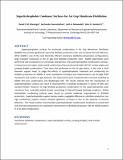Superhydrophobic condenser surfaces for air gap membrane distillation
Author(s)
Swaminathan, Jaichander; Maswadeh, Laith A.; Warsinger, David Elan Martin; Lienhard, John H
DownloadSuperhydrophobic Condenser Surfaces for Air Gap Membrane Distillation, Warsinger, 2015, no JMS formatting.pdf (1.899Mb)
OPEN_ACCESS_POLICY
Open Access Policy
Creative Commons Attribution-Noncommercial-Share Alike
Terms of use
Metadata
Show full item recordAbstract
Superhydrophobic surfaces for enhanced condensation in air gap membrane distillation (AGMD) may provide significantly improved distillate production rates and increased thermal efficiency. While AGMD is one of the most thermally efficient membrane distillation desalination configurations, large transport resistances in the air gap limit distillate production rates. AGMD experiments were performed with combinations of untreated, hydrophobic, and superhydrophobic condensation surfaces. A nanostructured copper oxide coated condensing surface produced durable 164°±4° contact angles and jumping droplet condensation. Tests were also performed on the air gap spacer, in this case a small diameter support mesh, to judge the effects of superhydrophobic treatment and conductivity on distillate production for AGMD. A novel visualization technique was implemented to see through PVDF membranes and confirm air gap behavior. The experiments were compared with numerical modeling of AGMD film-wise condensation and flooded-gap MD. The results indicate that the introduction of superhydrophobic surfaces can result in improvements in distillate production in excess of 60% over standard AGMD. However, for high distillate production, condensation on the superhydrophobic plate transitions from a partially wetted droplet morphology to Wenzel flooded (wetting) conditions. Mildly hydrophobic condensing surfaces were found to provide moderate improvement in distillate production. Superhydrophobic support meshes made a negligible difference in distillate production, but high conductivity support meshes showed significant increases in flux at the expense of increased conduction losses. The results outline recommended superhydrophobic condensation conditions at varied feed and cold side temperatures for substantial improvement to distillate production rate for AGMD systems in a flat plate configuration.
Date issued
2015-06Department
Massachusetts Institute of Technology. Abdul Latif Jameel World Water & Food Security Lab; Massachusetts Institute of Technology. Department of Mechanical EngineeringJournal
Journal of Membrane Science
Publisher
Elsevier
Citation
Warsinger, David E.M., Jaichander Swaminathan, Laith A. Maswadeh, and John H. Lienhard V. “Superhydrophobic Condenser Surfaces for Air Gap Membrane Distillation.” Journal of Membrane Science 492 (October 2015): 578–587.
Version: Author's final manuscript
ISSN
03767388